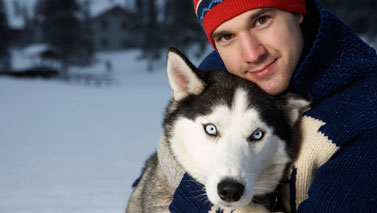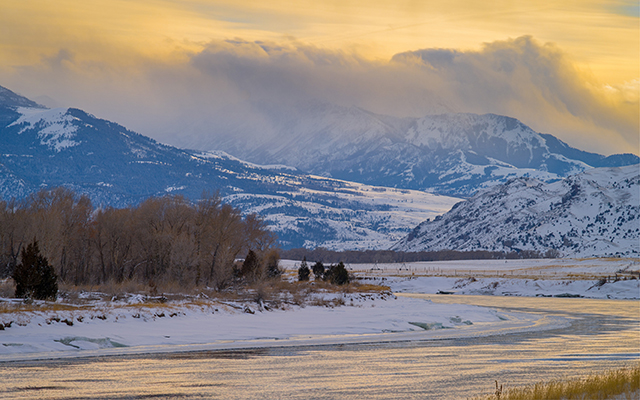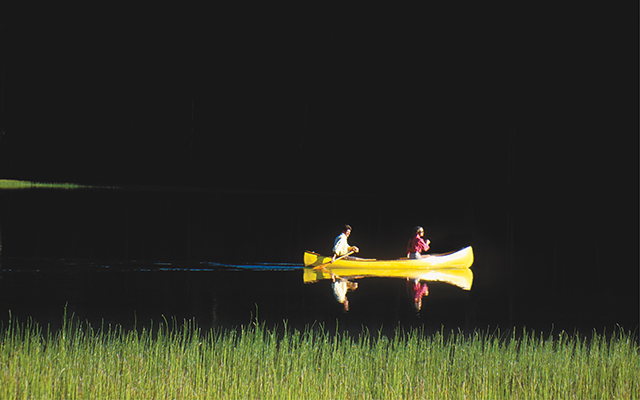During the spring, summer and fall, Moses Sarah Smith often took Thor — her energetic, 100-pound yellow lab — on long-distance runs. But during the winter, when Smith hit the snow-covered trails, Thor stayed home. That is, until the day Smith saw a dog pulling a cross-country skier. “I was like, ‘No way! My dog would love that,’” she recalls.
So the 33-year-old Minneapolis chiropractor bought a dog harness at a local cross-country ski shop. “I hooked him up and said, ‘Let’s go!’ she recalls, “and he looked at me like, ‘You’re crazy.’”
Thor eventually caught on, though. “At first he just bolted,” Smith says, laughing. “I wiped out a few times, but then we got the hang of it.”
Like many winter-sports enthusiasts, Smith had stumbled upon skijoring (Norwegian for “ski driving”), the fast-paced Nordic sport in which a harnessed dog (or two!) pulls a human on skis. Skijoring offers a welcome and outrageously fun alternative to wintertime inactivity for dogs — and for their owners. Popular for years in the mushing capitals of Scandinavia and Alaska, skijoring has just begun sweeping over America’s northern climes in the past decade or so, even making its way into some less-than-snowy mid-Atlantic states.
Dog Powered
From Washington State to upstate New York, from Colorado to Pennsylvania, Nordic ski centers and resorts are opening their trails to skijorers. Recreational skijoring clubs are bringing local enthusiasts together. And amateur to advanced competitions are elevating the sport to the ranks of its better-known cousin, dogsledding.
When former competitive downhill skier Steve Crone, 52, began skijoring in Maine 13 years ago, “very few people were doing it,” he says. Now it’s almost ubiquitous; just about anywhere you find cross-country skiers, you’ll find skijoring. It’s not uncommon to encounter dog-pulled skiers “crossing the roads to get to the trails on the other side,” he adds.
Crone’s Telemark Inn, near Bethel, Maine, offers year-round outdoor activities for animal lovers. And with a kennel of some 75 snow dogs, it’s a popular destination for dogsled tours and lessons. But skijoring is a favorite activity among guests, who either bring their own dogs or use the inn’s to explore the nearby trails.
“The beauty of skijoring is that it’s a simple sport. It takes minimal investment, unlike dogsledding. You have your skis, about $75 worth of equipment, and you and your dog go out and try to tap into your dog’s natural instinct to run,” says Crone. Other than standard cross-country gear, the only necessary equipment is a dog harness, a belt for the skier and a towline to attach the two. (See Web Extra! for equipment and instructional resources.)
Northern dog breeds — Alaskan and Siberian huskies, and malamutes, especially — are skijoring naturals. The instinct to pull loads over long distances is hardwired into their DNA, which is why they are widely used for dogsledding. But most dogs over 30 pounds and in good condition can learn to skijor — and they’d probably like nothing better than to spend a day with you on a snowy trail.
For their human companions, skijoring offers a winter thrill not usually found on flat terrain. “It’s awesome,” says Smith, a lifelong snow-sport enthusiast. “It’s almost like an extreme sport.” There are also dry-land versions of the sport: canicross (running or hiking with your harnessed dog), bikejor and rollerjor (biking and inline skating behind your dog).
Last year, Smith and Thor entered several amateur skijor races, including the City of Lakes Skijoring Loppet in Minneapolis. “It looks ridiculous, but when you finally get skijoring, it’s so cool,” Smith says. “You feel like such a rock star; you’re getting pulled three times faster than you can normally go, and the dog just loves it.”
Ready, Set, Hike!
With the right equipment and equal parts practice and patience, you can learn skijoring on your own, like Smith did. A number of books and videos can provide a basic tutorial, but many experienced skijorers say that getting some hands-on training can save you and your dog a lot of potential frustration — especially in the early stages, when you are trying to teach the dog to do exactly the opposite of what you’ve previously told him not to do.
“You need to train your dog to run out in front of you,” says Catherine Benson, whose Baltimore-based Maryland Sled Dog Adventures company offers skijoring instruction. “That’s counterintuitive to all the training that you’ve probably done up until this point. Most of their lives, they’ve been taught to heel.”
Skijoring training involves learning the basic commands (see “Dog Talk,” below), how to choose and attach a dog harness, and how to work with your dog to make the experience as easy and fun as possible. Sometimes during training, new dogs are paired with experienced ones that can show them the ropes. “Animals train other animals much better than people train animals,” Crone says.
Depending upon where you live, skijoring may be allowed on local Nordic ski-center trails. You can also ski with your dog on many municipal trails, fire roads and frozen lakes. Sharing the trail will help keep those opportunities available, enthusiasts say. “You have to maintain good dog-owner etiquette. We do coexist with multiuse users on the trails,” says Benson. (For more information on skijoring etiquette, see “Skijoring Do’s and Don’ts,” below.)
Before you try skijoring this winter, Crone recommends that you start conditioning your dog now by running him or her regularly and gradually increasing the distance and time. You also need to make sure that you can ski well enough to stay in control, he says. “The better skier you are, the less burden it will be on your dog.”
It’s not uncommon for healthy dogs to comfortably skijor for up to an hour, at speeds as fast as 15 miles per hour and covering as many as seven miles. Northern breeds can go much farther. But when your dog has had enough, you’ll know, Crone says. When she starts panting a lot with her tongue hanging out, slows to a trot or begins to frequently look back at you, it’s probably time to call it a day.
Man’s Best Friend
Kathryn Howell says the response to the skijor days offered by her Ontario, Canada–based company, Dog Paddling Adventures, has been “amazing.” Since introducing the sport to its clients in 2002, the company has begun offering introductory and advanced skijoring classes and events with “every type of dog you can imagine,” she says.
“So often dogs aren’t allowed to run much — or to pull, for that matter. With skijoring, they get a day outside in a season when dogs are often inside more than out, and they really get to have fun,” she says.
“The most amazing part of the day is seeing a dog and its owner truly connect on the trail,” she adds. “Working together to accomplish a goal is such an awesome bonding experience.”
This element, the opportunity to share an adventure with your dog that both of you enjoy, is perhaps skijoring’s biggest appeal. As Benson puts it, “There is nothing better — be it in Maine, Minnesota or Maryland — than gliding down a snow-covered trail with your canine best friend when it’s quiet, the trees are coated with fresh snow, and the only sound is the sound of skis on the snow and the jingle of your dog’s tags.”
Skijoring Do’s and Don’ts
Do:
- Ski the trail first so you are familiar with it.
- Keep your dog under control at all times.
- Be courteous to other skiers and snowshoers.
Don’t:
- Try skijoring unless you feel comfortable on cross-country skis.
- Let your dog run off leash in populated areas.
Dog Talk
Want to make sure that you and your canine friend speak the same language on the cross-country trails this winter? Teach him or her these basic skijoring commands:
- No: Stop whatever it’s doing
- Whoa: Slow down; stop
- Hike or OK: Start
- Gee: Turn right
- Haw: Turn left
- Gee over: Move to the right
- Haw over: Move to the left
- Good dog: Praise for a job well done
- Come: Come to skier
- Line out: Tighten towline
- On by: Keep going straight (used to instruct a dog not to stop for distractions)
Skijor Away
- Telemark Inn — With 20 kilometers of wooded trails near Bethel, Maine, you can learn and practice skijoring with your own dog or one borrowed from the inn. 207-836-2703; www.newenglanddogsledding.com
- Eden Mountain Lodge — Skijoring lessons and pet-friendly lodging in Eden Mills, Vt. 802-635-9070; www.edenmountainlodge.com
- Crystal Wood Lodge — A pet-friendly B&B in Klamath Falls, Ore., that caters to outdoor adventures with your dog year-round. 866-381-2322; www.crystalwoodlodge.com
- Justin Trails Resort — Enjoy a 2-kilometer dog trail groomed for either skijoring or skiing with your dog off leash in Sparta, Wis. 800-488-4521; www.justintrails.com
Learn More
- www.sleddogcentral.com/skijoring.htm — This site provides a basic overview of the sport, along with articles, race schedules and equipment.
- www.skijor.org — Home of the Midwest Skijorers Club, this site has skijoring tutorials and information on races and clinics.




This Post Has 0 Comments